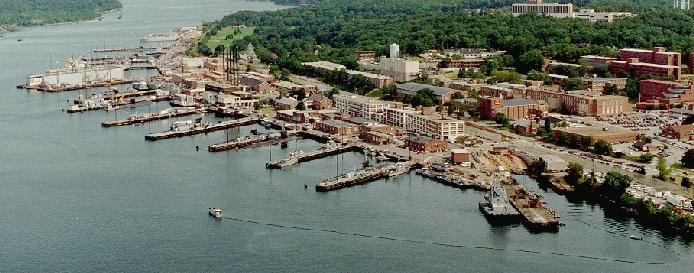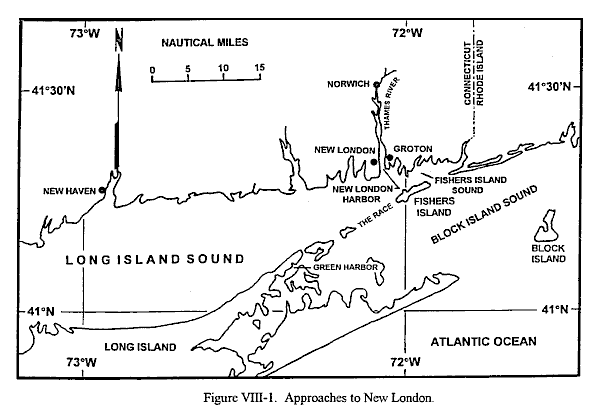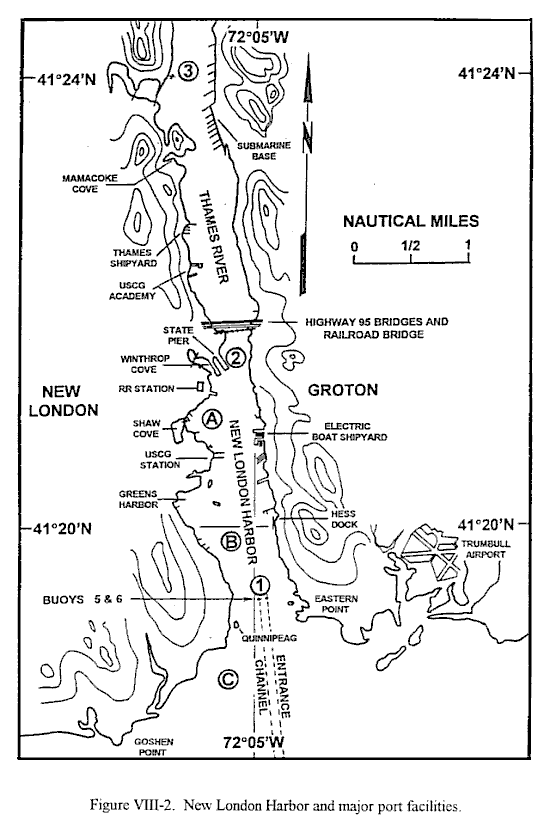






The base supports twenty one attack submarines and the Navy's nuclear research deep submersible NR-1. The base occupies approximately 500 acres and has over 400 buildings, with the housing and support facilities for 10,000 active duty and civilian workers and their families.
New London Harbor is on the northern shore of Long Island Sound at the mouth of the Thames River, including the ports of New London and Groton, and the Naval Submarine Base (SUBASE). The main harbor comprises the lower three miles of the river from Long Island Sound to the vicinity of the bascule railroad bridge and twin Highway 95 bridges that span the river between New London and Groton. The main harbor includes Greens Harbor, Shaw Cove, and Winthrop Cove. The inner harbor extends approximately nine miles upriver from the highway bridges to the city of Norwich, CT. The main harbor is open to the south through the mouth of the Thames River. Hills or bluffs with elevations exceeding 100 ft exist east and west of the main harbor except for some fairly flat topography on the lower portion of the harbor's eastern shore. The low elevations expose the harbor to southeasterly winds. The topography is more pronounced along the river above the highway bridges. Bluffs exceeding 200 ft on both sides of the river create a channel for north and south winds. Many references state that the channel depth is 40 ft to the mouth of New London Harbor and 36 ft from New London Harbor to the SUBASE. However, SUBASE harbor pilots state that dredging had increased the channel depth to 40 ft from the mouth of the Thames River all the way to the SUBASE. The harbor pilots further state that the newly dredged depth is still insufficient for Ohio Class submarines to safely proceed upriver to the SUBASE. The upriver limit of Ohio Class submarines is a line approximately between the U.S. Coast Guard Station on the west side of the Thames River and the Electric Boat facility on the east side. The SUBASE is located on the Groton (east) side of the Thames River approximately 1-1/2 nmi north of the highway and railroad bridges which separate the main and inner harbors. The SUBASE pier complex consists of a mix of concrete piers and wooden piers. Most of the piers have deck heights approximately 5 ft above high tide level or approximately 8 ft above mean low water (MLW). An ongoing construction project is gradually replacing the older, wooden piers with more modern and substantial concrete piers. As of October 1996, a total of 15 submarine berths were available. The adjacent topography which provides considerable shelter from the easterly components of wind. It should be noted that the potential storm surge height at the SUBASE is calculated to be 17.4 ft in a worst case scenario, or approximately 6.2 ft above the 100-year flood level. In this instance a worst case storm is a Category 4 hurricane moving north at a 60 kt forward speed of movement. A pilot is required for all submarine arrivals and departures at the SUBASE. Arriving submarines will normally board pilots north of buoys 5 and 6. According to DMAHTC (1995), boarding south of the buoys can be imprudent due to cross channel current set. Pilots will normally remain on departing submarines until the vessels are south of the highway bridges.The SUBASE has a complement of two U.S. Navy YTB class (2,000 hp) tug boats, one 2,600 hp tug and one 1,600 hp tug to assist submarines and other vessels at the facility. One tug will be assigned for arrivals and departures of all naval ships, except that two tugs are to be used for SSBN submarines. Three tugs are required for any undocking. According to Fleet Guide New London, the Electric Boat Company provides tugs for ships undergoing contractual trials regardless of berth location. New London Harbor has several commercial tugs up to 3,200 hp available for use at the port. Arriving commercial vessels usually go to the inner harbor without assistance, although a tug may be required when head winds and contrary currents exist. Large vessels normally require tugs for docking and undocking evolutions.
Four general use anchorages exist in the New London Harbor area, designated as anchorages A, B, C and E. The locations of Anchorages A, B, and C are within the limits of New London Harbor. Anchorage E is located approximately 1/2 nmi east-southeast of the seaward end of the entrance channel. All are said to provide good holding. Anchorage A has depths of only 15 to 18 ft at mean lower low water (MLLW) and a bottom of mud and soft mud. Anchorages B and C have depths of 20 to 30 ft with a mud bottom. Anchorage E has depths of 42 to 50 ft, with an unspecified bottom type. The preceding bottom types have been interpolated from sparse descriptive data printed on DMAHTC Chart 13213. Other bottom types may exist in the anchorages.New London Harbor has more than 30 wharves and piers of various sizes and configurations, which are used as repair berths and for mooring recreational craft, fishing vessels, tugs, barges, ferries and government vessels. Depths alongside the various facilities range from 10 to 30 ft.
Berthing at the U.S. Coast Guard Station consists of two large piers, Pier 4 and Pier 7, and other mooring facilities for small craft. Piers 4 and 7 were formerly assets of the Naval Undersea Warfare Center (NUWC). NUWC closed as of January 1, 1997 and turned the piers over to the control of the U.S. Coast Guard Station. The northernmost pier, Pier 7, is a 656 ft concrete pier capable of accommodating one Ohio Class submarine on its north side. Water depth on the north side of the pier is 42 ft at mean low water (MLW). Shallower depths exist on the south side of the pier. Deck height is approximately 15 ft above MLW. Pier 4 is a 555 ft long, wooden pier. Depths alongside Pier 4 are 19-20 ft at MLW. Deck height is approximately 8 ft above MLW. Pier 4 is exposed to seas moving northward into the harbor. Pier 7 is afforded limited protection from wave motion by Pier 4.State Pier is located on the west side of the Thames River just south of the railroad bridge. The pier was previously leased and controlled by the U.S. Navy because the USS Fulton, a submarine tender, was semi-permanently moored to four concrete dolphins located just northeast of the pier. The Fulton was decommissioned and no replacement vessel was assigned. The pier has now reverted to civilian use. As of October 1996, the pier was undergoing extensive renovations. Before renovations, the deck height of the pier was 10 ft above MLW. Alongside depths vary from 39 ft at MLW on the east side, 30 ft on the face, and 29 to 33 ft on the west side. When leased by the U.S. Navy it was normal practice for departing vessels moored at the pier to back into the center of the channel and then proceed forward, down the channel to Long Island Sound.
The Coast Guard Academy Pier is used by the Academy's sailing ship Eagle (WIX-327), a Coast Guard Cutter, and miscellaneous small craft. Depths alongside the 410 ft long pier range from 17 ft on the face, 19 ft along the south side, and 15 to 17 ft on the north side. The pier is exposed to southerly winds.
The Electric Boat Division of General Dynamics Corporation has a variety of docks with deck heights approximately 6 ft above MLW. The facility is reserved for ship building, refitting and repair. Submarines in various states of repair may be found there, including unmanned new construction vessels. The facility also has a variety of barges, including berthing barges for the personnel of vessels undergoing refitting or repair.
Hess Dock is privately owned by the Hess Oil and Chemical Division, Amerada Hess Corporation. The facility is located on the east side of the Thames River opposite Greens Harbor. The T-headed pier has a 55 ft face and 960 ft of berthing space, with dolphins. Deck height is 8 ft with an alongside depth of 40 ft. Use of the facility is primarily limited to oil and chemical barges. Larger vessels go to one of the four anchorages available at New London.
Greens Harbor is a small craft basin with general depths of 6 to 17 ft. Located just north of the New London Harbor entrance, Greens Harbor is exposed to southeast winds. Shaw Cove is a well protected, dredged basin for small craft located between the Coast Guard Station and the downtown New London wharves. A railroad bridge with a swing span crosses over the entrance to Shaw Cove. Clearance under the span is 6-1/2 ft. Winthrop Cove, at the northern edge of the downtown New London wharf area, contains facilities for ferry boats making regular runs to/from the harbor. Winthrop Cove is exposed to southeasterly winds.



